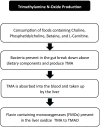The gut-heart axis: a review of gut microbiota, dysbiosis, and cardiovascular disease development
- PMID: 40109640
- PMCID: PMC11918638
- DOI: 10.1097/MS9.0000000000002789
The gut-heart axis: a review of gut microbiota, dysbiosis, and cardiovascular disease development
Abstract
Background: Cardiovascular diseases (CVDs) are a major cause of morbidity and mortality worldwide and there are strong links existing between gut health and cardiovascular health. Gut microbial diversity determines gut health. Dysbiosis, described as altered gut microbiota, causes bacterial translocations and abnormal gut byproducts resulting in systemic inflammation.
Objective: To review the current literature on the relationships between gut microbiota, dysbiosis, and CVD development, and explore therapeutic methods to prevent dysbiosis and support cardiovascular health.
Summary: Dysbiosis increases levels of pro-inflammatory substances while reducing those of anti-inflammatory substances. This accumulative inflammatory effect negatively modulates the immune system and promotes vascular dysfunction and atherosclerosis. High Firmicutes to Bacteroidetes ratios, high trimethylamine-n-oxide to short-chain fatty acid ratios, high indole sulfate levels, low cardiac output, and polypharmacy are all associated with worse cardiovascular outcomes. Supplementation with prebiotics and probiotics potentially alleviates some CVD risk. Blood and stool samples may be used in clinical practice to quantify and qualify gut bacterial ratios and byproducts, assess patients' risk for adverse cardiovascular outcomes, and track their gut health progress. Further research is required to set population-based cutoffs for normal and abnormal gut microbiota and byproduct ratios.
Keywords: atherosclerosis and dysbiosis; dysbiosis; gut microbiota; gut–heart axis; polypharmacy and dysbiosis.
Copyright © 2025 The Author(s). Published by Wolters Kluwer Health, Inc.
Conflict of interest statement
All the authors declare to have no conflicts of interest relevant to this study.
Figures




References
Publication types
LinkOut - more resources
Full Text Sources
